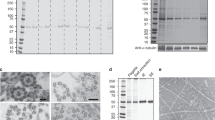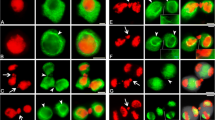Summary
Indirect immunofluorescence has revealed various intracytoplasmic microtubular structures, which are transiently polymerized in specific subcellular locations during the developmental process of conjugation in the ciliateTetrahymena thermophila. These structures include: (1) micronuclear spindles, (2) perimicronuclear microtubules, (3) microtubular baskets surrounding migrating pronuclei, and (4) microtubules interconnecting the pronuclei with the conjugants' junctional zone. Furthermore, a peripheral network of intracytoplasmic microtubules related to the cell cortex is present in both vegetative cells and in conjugants. Comparative observations made on cells undergoing normal conjugation and defective conjugation (occurring either spontaneously or induced by taxol) has revealed some rules governing the pattern of deployment of conjugation-specific microtubules. The presence of perinuclear microtubular arrays during early postmeiotic stages of development is strictly limited to more anteriorly located nuclei which includes the selected haploid nucleus that further divides to form the stationary and migratory pronuclei. These perinuclear microtubules may be involved in the positional control of nuclear fates leading to effective nuclear selection. Microtubular bundles associated with pronuclei and connecting the junctional zone are only formed in the presence of functional pronuclei, and may be involved in the guidance of pronuclei leading to their fusion. The mechanism of cytoplasmic control of nuclear differentiation of derivatives of the zygotic nucleus appear to be associated with a coordinate action of two microtubular arrays: spindle microtubules of the second postzygotic division and the peripheral intracytoplasmic network of microtubules, leading to a proper subcortical positioning of the postzygotic nuclei at opposite poles of the cell.
Similar content being viewed by others
Abbreviations
- MTs:
-
Microtubules
References
Adoutte A, Claisse M, Maunoury R, Beisson J (1985) Tubulin evolution: conservation of protozoan specific epitopes in the ciliary tubulins of vertebrates. J Mol Evol 22: 220–229
Allen SL (1967) Genomic exclusion: a rapid means for inducing homozygous diploid lines ofTetrahymena pyriformis, syngen 1. Science 155: 575–577
Blose SH, Meltzer DI, Feramisco JR (1984) 10 nm filaments induced to collapse in cells microinjected with antibodies against tubulin. J Cell Biol 95: 229A
Cohen J, Beisson J (1988) The cytoskeleton. In: Gortz H-D (ed) Paramecium. Springer, Berlin Heidelberg New York Tokyo, pp 363–392
— —, Tucker JB (1980) Abnormal microtubule deployment during defective macronuclear division in aParamecium mutant. J Cell Sci 44: 153–167
— —, Adoutte A, Grandchamp S, Houdebine L-M, Beisson J(1982) Immunocytochemical study of micro tubular structures throughout the cell cycle ofParamecium. Biol Cell 44: 35–44
Delgado MA, Conde J (1984) Benomyl prevents nuclear fusion inSaccharomyces cerevisiae. Mol Gen Genet 193: 188–189
Doerder FP, Shabathura SK (1980) Genomic exclusion inTetrahymena thermophila: a cytogenetic and cytofluorimetric study. Dev Genet 1: 205–218
Elinson RP (1990) Cytoskeleton and embryo polarity. Curr Opin Cell Biol 2: 75–79
Gaertig J, Kaczanowski A (1987) Correlation between the shortened period of cell pairing during genomic exclusion and the block in posttransfer nuclear development inTetrahymena thermophila. Dev Growth Differ 29: 553–562
—, Seyfert H-M, Kaczanowski A (1986) Post-meiotic DNA synthesis in nocodazole blocked nuclei during conjugation ofTetrahymena thermophila. Induction of polyploidy in the micronucleus. Exp Cell Res 164: 562–567
Grandchamp S, Beisson J (1981) Positional control of nuclear differentiation inParamecium. Dev Biol 81: 336–341
Hamilton EP, Suhr-Jessen PB (1980) Autoradiographic evidence for self-fertilization inTetrahymena thermophila. Exp Cell Res 126: 391–396
— —, Orias E (1988) Pronuclear fusion failure: an alternate conjugational pathway inTetrahymena thermophila induced by vinblastin. Genetics 118: 627–636
Huffaker TC, Thomas JH, Botstein D (1988) Diverse effects of β- tubulin mutations on microtubule formation and function. J Cell Biol 106: 1997–2010
Jacobs CW, Adams AEM, Staniszlo PJ, Pringle JR (1988) Functions of micro tubules in theSaccharomyces cerevisiae cell cycle. J Cell Biol 107: 1409–1426
Jones JCR, Tucker JB (1981) Microtubule organizing centers and assembly of the double-spiral microtubule pattern in certain heliozoan axonemes. J Cell Sci 50: 259–280
Jurand A (1976) Some ultrastructural features of micronuclei during conjugation and autogamy inParamecium aurelia. J Gen Microb 94: 193–203
Kaczanowski A, Gaertig J, Kubiak J (1985) Effect of the antitubulin drug nocodazole on meiosis and postmeiotic development inTetrahymena thermophila. Induction of achiasmatic meiosis. Exp Cell Res 158: 244–256
—, Gornicka I, Cleffmann G (1989) Arrest of micronuclear DNA replication during genomic exclusion inTetrahymena produces haploid strains. Genetics 121: 37–45
Lanners HN (1980) Pronuclei ofHeliophyra erhardi Matthes during conjugation and their association with coated and uncoated microtubules. J Cell Sci 45: 245–256
Martindale DW, Allis CD, Bruns PJ (1982) Conjugation inTetrahymena thermophila. A temporal analysis of cytological stages. Exp Cell Res 140: 227–236
Maupas E (1889) Le rajeunissement karyogamique chez les cilies. Arch Zool Exp Gen Ser 27: 149–517
Mikami K (1980) Differentiation of somatic and germinal nuclei correlated with intracellular localization inParamecium caudatum exconjugants. Dev Biol 80: 46–55
Nanney DL (1953) Nucleo-cytoplasmic interaction during conjugation inTetrahymena. Biol Bull 105: 133–148
—, Nagel MJ (1964) Nuclear misbehavior in an aberrant inbredTetrahymena. J Protozool 11: 465–473
Numata O, Sugai T, Watanabe Y (1985) Control of germ cell nuclear behavior at fertilization byTetrahymena intermediate filament protein. Nature 314: 192–194
Orias E (1986) Ciliate conjugation. In: Gall JG (ed) The molecular biology of ciliated protozoa. Academic Press, New York, pp 45–84
—, Hamilton EP, Orias E (1983) A microtubule meshwork associated with gametic pronucleus transfer across a cell-cell junction. Science 222: 181–184
Ruiz F, Adoutte A, Rossignol M, Beisson J (1976) Genetic analysis of morphogenetic processes inParamecium. I. A mutation affecting trichocysts formation and nuclear division. Genet Res Cambr 27: 109–122
Schiff PB, Horwitz SB (1980) Taxol stabilizes microtubules in mouse fibroblast cells. Proc Natl Acad Sci USA 77: 1561–1565
Schliwa M, Van Blerkom J (1981) Structural interaction of cytoskeletal components. J Cell Biol 94: 455–465
Scholnick SB, Bruns PJ (1982) A genetic analysis ofTetrahymena that have aborted normal development. Genetics 102: 29–38
Sugai T, Hiwatashi K (1974) Cytologie and autoradiographic studies of the micronucleus at meiotic prophase inTetrahymena pyriformis. J Protozool 21: 542–548
Torres A, Delgado P (1989) Effects of cold and nocodazole treatments on the microtubular systems ofParamecium in interphase. J Protozool 36: 113–119
Weindruch RH, Doerder FP (1975) Age-dependent micronuclear deterioration inTetrahymena pyriformis. Mech Ageing Dev 4: 263–280
Wolfe J, Hunter B, Adair WS (1976) A cytological study of micronuclear elongation during conjugation inTetrahymena. Chromosoma 55: 289–308
Yanagi A (1987) Positional control of the fates of nuclei produced after meiosis inParamecium caudatum. Analysis by nuclear transplantation. Dev Biol 122: 535–539
Author information
Authors and Affiliations
Rights and permissions
About this article
Cite this article
Gaertig, J., Fleury, A. Spatio-temporal reorganization of intracytoplasmic microtubules is associated with nuclear selection and differentiation during the developmental process in the ciliateTetrahymena thermophila . Protoplasma 167, 74–87 (1992). https://doi.org/10.1007/BF01353583
Received:
Accepted:
Issue Date:
DOI: https://doi.org/10.1007/BF01353583




